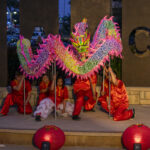Dr. Jim Buchholz, California Baptist University professor of mathematics and physics, agreed in April 2011 to plan the American Science Affiliation’s annual meeting this summer, a venture that usually takes two years.
Buchholz, however, accepted the challenge to plan the meeting in just one year. The ASA meeting of Christian scientists with backgrounds in math, science, engineering and philosophy took place July 20–23 at Point Loma Nazarene University.
“I realized I had a short amount of time to plan,” Buchholz said. “Most program chairs are asked two years in advance, and during the first year they’re working on a lot of things and finding the plenary speakers, and you usually know the plenary speakers already a year out.”
A program chair must first decide on a theme and verse around which to plan the meeting.
Buchholz chose Ephesians 4:25 as the verse. From there he grew the theme, “Science, Faith and the Media: Communicating Beyond Books,”
something which the organization had never considered or presented before in its annual meetings.
“It was going to be very much of a communication theme,” Buchholz said. “For the majority of our communication — those of us in the field of science and faith — it is done through literature, reading and writing books.”
Buchholz said he wanted to explore new ways of communication and how to take the science and faith community and communicate with others outside of textbooks.
“The only people buying science and faith textbooks are the people who are in our field,” Buchholz said. “So how do we communicate more with not only people on our field but also people outside of our field?”
Buchholz said he saw the opportunities for communication through film, movies, the Internet and social media, and made the conference unique by including those aspects not as a part of it but as the main theme.
The plenary speeches are given by those with a background in the categories that make up the group. The group reviews different areas of
construction going on between math, science, engineering or philosophy that relates to their Christian faith.
However, this conference was different, with only one of the six plenary speakers being a scientist. The speakers varied with those experienced in film, communications, journalism and public relations.
The lone scientist, Dr. John E. Johnson, the Eldon R. Strahm endowed chair in structural virology at the Scripps Research Institute, although talking about viruses, showed how he reaches those outside the field through creating animations that give an easier understanding.
“Talks based on the theme, ‘Science, Faith and the Media,’ opened the eyes of many participants as we explored how we can better convey the many harmonies between the truths of faith and the discoveries of science to individuals who only see these disciplines as being at odds with one another,” said Dr. Thomas E. Ferko, CBU professor of chemistry and the president of Southern California in Science.
Along with the plenary speakers, 40 papers were shared over the
course of three days. Also, poster board presentations were given by students.
Among those students was Edith N. Waskel, CBU senior biology major, who gave a presentation on the research she did at a lab in Loma Linda University’s Medical Center.
“The research I was involved in focused on trying to understand the cell-signaling pathway responsible for the development of pulmonary hypertension due to the effects of chronic hypoxia,” Waskel said.
Waskel said she was nervous about presenting in front of accomplished scientists and researchers at first but found the environment friendly and encouraging. The welcoming atmosphere made presenting easier, she said.
Of the 200 attendees, 32 were students, making the total of students present higher than it has been in the past. Buchholz said about half of the students were from CBU.
“I really enjoyed being able to meet well known film producers and getting to know my professors’ passion and interests outside of the classroom setting,” Waskel said. “The sessions had a variety of topics
and really got the audience thinking about real controversies between the church and science.”
Buchholz said he feels technology needs to be investigated as it continues to change because the opportunity for potential change can be missed if it is not investigated.
Buchholz added that he remembers as a child a conversation between his father and a colleague regarding the introduction of computers into classrooms. He observed that having not grown up with computers, his father still believed they were the future. Even now, Buchholz said he sees the Internet is giving online education new meaning.
Prior to the conference, Buchholz said he saw the organization as being the same for a long time, but now there are so many possibilities that the organization would not have seen without having this year’s theme.
“We’re even now discussing the possibility of things like doing webisodes,” Buchholz said. “… So as technology changes for the better or worse, as it changes you need to ask, ‘Is there anything in it that we need to learn and use?’


